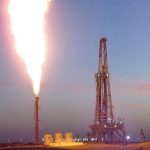NEW YORK: US natural gas futures climbed about 2% to a 10-week high on lower daily output and forecasts for hotter weather and higher demand over the next two weeks than previously expected.
That heat should prompt homes and businesses to crank up their air conditioners, which should push power generators to burn more gas to produce electricity to keep those air conditioners humming.
Analyst said that heat would likely come at the same time some liquefied natural gas (LNG) export plants exit maintenance reductions, which should boost the amount of gas flowing to the export plants.
Gas futures for July delivery on the New York Mercantile Exchange rose 6.8 cents, or 1.8%, to $3.919 per million British thermal units (mmBtu), putting the contract on track for its highest close since April 3 for a second day in a row.
That price increase came despite forecasts by some analysts that energy firms may have set another storage record with an eighth triple-digit injection during the week ended June 13.
The average estimate of most analysts, however, was that energy firms added a slightly smaller 98 billion cubic feet (bcf) of gas into storage, which is still much bigger than the 72-bcf normal for this time of year and the 72 bcf injected during the same week last year.
The US Energy Information Administration will release the June 13 storage report a day earlier than usual on Wednesday, June 18, due to the US Juneteenth holiday on Thursday, June 19. During the prior week ended June 6, energy firms added 100 bcf or more of gas into storage for a seventh week in a row, tying the seven-week triple-digit injection record set in June 2014, according to federal energy data going back to 2010.
So far this year, energy firms have pulled a monthly record high of 1.013 trillion cubic feet of gas out of storage in January when brutally cold weather boosted heating demand and added a monthly record high of 497 bcf into storage in May when mild weather kept both heating and cooling use low, according to federal energy data. The prior all-time monthly injection high was 494 bcf in May 2015.






